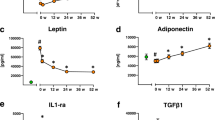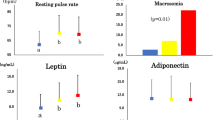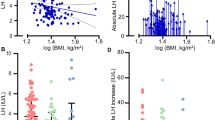Abstract
OBJECTIVE: To examine potential interactions between abdominal obesity, endocrine, metabolic and hemodynamic perturbations.
SUBJECTS: A subgroup of 284 men from a population sample of 1040 at the age of 51 y.
MEASUREMENTS: Anthropometric measurements included body mass index (BMI, kg/m2), waist/hip circumference ratio (WHR) and abdominal sagittal diameter (D). Endocrine measurements were a modified, low dose (0.5 mg) dexamethasone suppression test (Dex), testosterone (T) and insulin-like growth factor I (IGF-I). Overnight fasting values of blood glucose, serum insulin, triglycerides, total, low and high density lipoprotein cholesterol, as well as resting heart rate and blood pressure were also determined.
RESULTS: Arbitrary subdivisions of the men were performed to obtain subgroups of low T and IGF-I values (lowest decile, borderlines ≤13.13 nmol/l and ≤128.80 μ <$>\kern-4.5 <$>μg/l, respectively) and normal or blunted Dex. Significant relationships with BMI, WHR or D, and abnormal metabolic and hemodynamic factors, usually with the exception of total and low density lipoprotein cholesterol, were then found in subgroups with different endocrine profiles. These included men with a blunted Dex test with low T or IGF-I values, as well as men with a normal Dex test and low or normal T or IGF-I values. In addition, a group with isolated low Dex suppression, as well as another group without endocrine abnormalities, showed such relationships. These findings suggest that, in men, obesity factors are associated with metabolic and hemodynamic complications with or without the presence of perturbations of hypothalamic-pituitary-adrenal axis (HPA) regulation or low T or growth hormone secretion.
In order to generate hypotheses concerning the nature of the impact of the endocrine perturbations in abdominal obesity and its metabolic complications, path analyses were performed, testing different models. These models included the endocrine measurements (Dex test, T and IGF-I), the WHR and D (representing abdominal distribution of fat), BMI (representing obesity), as well as insulin and triglyceride values (representing metabolic perturbations). The results showed a satisfactory fit (goodness-of-fit index: 0.945 – 1.0) for the path diagrams: Dex → T/IGF-I → WHR or D → insulin → triglycerides with additional direct input of blunted Dex on insulin values (see ). With BMI as determinant, essentially the same results were found with the addition of a direct pathway between Dex and BMI as well as between IGF-I-T and insulin (). There was no evidence for pathways where WHR or BMI determined endocrine variables.
CONCLUSIONS: The results suggest that abdominal obesity with or without endocrine abnormalities exerts a major impact on abnormalities in metabolic and hemodynamic variables. Abdominal obesity seems to be dependent on endocrine abnormalities, which in turn show direct or indirect relationships to the metabolic and circulatory variables, including a direct pathway between HPA-axis perturbations and accumulation of total body fat as indicated by the BMI.
It is therefore suggested that endocrine perturbations are followed by obesity and by storage of an elevated proportion of fat in visceral depots, followed by metabolic and hemodynamic abnormalities. This is statistical evidence which is supported by evidence of mechanistic links in previous studies, suggesting the possibility of causal relationships. The results also indicate subgroups of abdominal obesity and its associated metabolic and hemodynamic abnormalities, which might be due to the input of different pathogenetic factors.
This is a preview of subscription content, access via your institution
Access options
Subscribe to this journal
Receive 12 print issues and online access
$259.00 per year
only $21.58 per issue
Buy this article
- Purchase on Springer Link
- Instant access to full article PDF
Prices may be subject to local taxes which are calculated during checkout
Similar content being viewed by others
Author information
Authors and Affiliations
Rights and permissions
About this article
Cite this article
Rosmond, R., Björntorp, P. The interactions between hypothalamic-pituitary-adrenal axis activity, testosterone, insulin-like growth factor I and abdominal obesity with metabolism and blood pressure in men. Int J Obes 22, 1184–1196 (1998). https://doi.org/10.1038/sj.ijo.0800745
Received:
Revised:
Accepted:
Published:
Issue Date:
DOI: https://doi.org/10.1038/sj.ijo.0800745
Keywords
This article is cited by
-
Psychological comorbidity in diabetes mellitus—need for early recognition and treatment
International Journal of Diabetes in Developing Countries (2018)
-
A Weighty Issue: Diminished Net Nutrition Among the U.S. Working Class in the Nineteenth Century
Demography (2015)
-
Influence of Bcl-1 Gene Polymorphism of Glucocorticoid Receptor Gene (NR3C1, rs41423247) on Blood Pressure, Glucose in Northern Indians
Indian Journal of Clinical Biochemistry (2011)
-
Regulation of 11β‐HSD Genes in Human Adipose Tissue: Influence of Central Obesity and Weight Loss
Obesity Research (2004)
-
Pleiotropic Relationships between Cortisol Levels and Adiposity: The HERITAGE Family Study
Obesity Research (2002)



